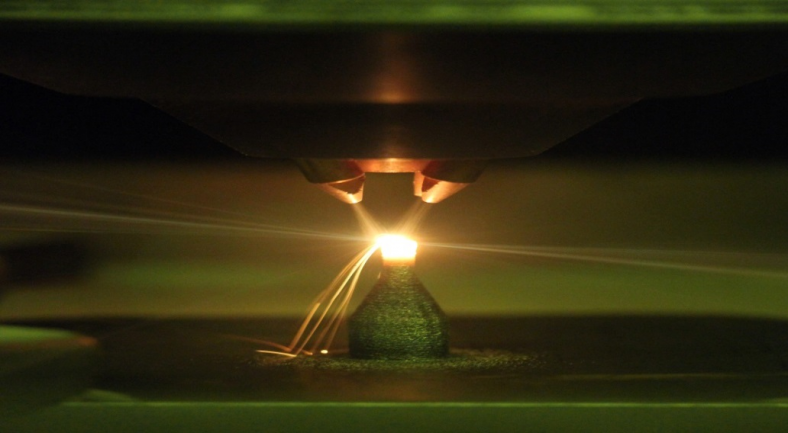A new study from scientists at the UCLA Jonsson Comprehensive Cancer Center found that emerging drugs that activate the protein STING, a well-established regulator of immune cell activation, substantially alter the activity of metabolic pathways responsible for generating the nucleotide building blocks for DNA.
Month: September 2021
Pivotal discovery of nanomaterial for LEDs
Perovskite nanocrystals have been prime candidates as a new material for LEDs but have proved unstable on testing. Scientists have discovered a method for stabilizing them, which have applications for consumer electronics, detectors and medical imaging.
Penn Nursing Researcher Awarded $3 Million for Study on Improving Lymphedema Care Delivery
A research team led by Penn Nursing’s Jie Deng, PhD, RN, OCN, FAAN, Associate Professor of Nursing in the Department of Biobehavioral Health Sciences, has been approved for a $3 million funding award by the Patient-Centered Outcomes Research Institute (PCORI) to study lymphedema management in head and neck cancer survivors.
The Osteoarthritis Action Alliance, Arthritis Foundation, and Centers for Disease Control and Prevention Release ‘Action Briefs’ to Help Leaders in Key Sectors Promote Prevention, Early Detection and Management of Osteoarthritis
The newly released Action Briefs now make it easier for employers, insurers, healthcare systems, policy makers, and leaders in other organizations to take specific, practical actions to support their constituents with osteoarthritis, by providing tools and resources to help prevent joint injuries and reduce the pain and disability associated with the disease.
Kristen D. Krause Joins the Rutgers School of Public Health
The Rutgers School of Public Health is excited to announce that Kristen D. Krause, PhD, MPH, has joined the Department of Urban-Global Public Health.
Older Patients Benefit from Cancer Immunotherapies
A retrospective analysis of large datasets of biomarkers from tumors and healthy tissue by researchers at the Johns Hopkins Kimmel Cancer Center Convergence Institute suggests that older cancer patients could benefit as much as younger patients from cancer immunotherapies.
Nanofiber Face Masks Improve Filtration Efficiency, Need Replacing More Often
Innovations to improve mask efficacy, with increasing focus on nanofiber manufacturing, have resulted in higher filtration efficiency, greater comfort, and easier breathing capacity. However, the effects of microwater droplets on the integrity of nanofibers are relatively unclear. In Physics of Fluids, researchers examine these ambiguities through a visualization of nanofibers interacting with water aerosol exposure. They used high-speed microscopic videos to systematically visualize the evolution of nanofibers with different contact angles, diameters, and mesh sizes under water aerosol exposure.
Tea Time Gets Flavor Boost from Thin Film, Impure Water
In Physics of Fluids, researchers describe how they applied rheology to the seemingly quaint purpose of improving the quality of a cup of black tea. They describe the interfacial phenomenon in a cup left to cool after steeping, when a thin film at the air-water interface can form, and assess the mechanical properties of the film, the formation of which is affected by water hardness, acidity, sugar or milk, tea concentration, and brewing temperature.
Memorial Sloan Kettering Cancer Center Receives Highly Competitive NCI SPORE Grant for Leukemia Research with a Focus on Acute Myeloid Leukemia
The National Cancer Institute (NCI) recently awarded Memorial Sloan Kettering Cancer Center (MSK) with a prestigious Specialized Programs of Research Excellence (SPORE) grant for leukemia research. The Translational Research Program (TRP) is the home of the SPOREs — a cornerstone of NCI’s efforts to promote collaborative, interdisciplinary translational cancer research.
Setting the Stage for Controlling Hypertension: New Paper Outlines Study Elements Needed to Address Dietary Contributors to Risk
Carefully designed research is key to understanding the role of the dietary sodium-to-potassium ratio in blood pressure changes
Study: Dental implant surfaces play major role in tissue attachment, warding off unwanted bacteria
The surface of implants, as well as other medical devices, plays a significant role in the adsorption of oral proteins and the colonization by unwanted microorganisms (a process known as biofouling), according to a new study led by the University at Buffalo and the University of Regensburg.
Research provides evidence for how a key transcription factor manages access to DNA
St. Jude Children’s Research Hospital scientists have revealed a previously unknown role for CTCF, a pivotal transcription regulator linked to cancer.
History of traumatic brain injury linked to higher rates of prescription opioid use and misuse
Adults with a history of traumatic brain injury (TBI), even years previously, are at increased risk of use and misuse of prescription opioid medications, reports a study in the September/October special issue of the Journal of Head Trauma Rehabilitation (JHTR).

What if the secret to your brain’s elusive computing power is its randomness?
Scientists at Sandia National Laboratories are creating a concept for a new kind of computer for solving complex probability problems that involve random chance.
Understanding Emotional Health and Childhood Cancer
Karen Long-Traynor, PhD, clinical psychologist in the Pediatric Hematology/Oncology Program at Rutgers Cancer Institute of New Jersey, addresses the psychological effects of childhood cancer on children and their families.
Apologizing to customers after product failures can encourage repurchase, stave off lawsuits
Companies that express remorse in the wake of a product failure are more likely to encourage customers to repurchase from them, according to new research from Binghamton University, State University of New York.
“Automated Vaccine Filling Machine”, An Innovation from Chulalongkorn University, Helps Boost the Number of Vaccinations by 20 Percent, and Reduce the Workload of Medical Personnel
The Faculty of Engineering, Chulalongkorn University has developed an automated vaccine filling machine that can fill AstraZeneca vaccine into syringes with precision, speed, and safety, helping to increase the number of vaccinated people by 20 percent. The prototype is now operating at Chula Vaccination Center and more machines are planned to be built to support frontline medical personnel in many vaccination centers soon.
21.4% record efficiency for flexible CIGS solar cells
A new efficiency record of 21.4% for flexible CIGS solar cell on polymer film has been achieved by scientists at Empa. Solar cells of this type are especially suited for applications on roofs, transport vehicles or mobile devices.
Surroundings affect rhythm of an individual’s walk, according to new study
Stepping patterns become slower and more variable if a person is uncomfortable with their surroundings, researchers have found.
Mount Sinai Health System Launches Comprehensive Mobile App for Patients
New features include upload for COVID-19 vaccination proof and hospital navigation
American Academy of Sleep Medicine organizes second annual Student Sleep Health Week
As many students return to classrooms for the first time in more than a year, the American Academy of Sleep Medicine encourages students, families, and teachers to recognize that sleep is essential for health and learning. To highlight the importance of healthy sleep for students, the AASM is organizing the second annual Student Sleep Health Week, Sept. 12-18, 2021.
Sesame cultivation: expansion versus temperature stress
Increasing genetic diversity protects against total crop failure
These fridge-free COVID-19 vaccines are grown in plants and bacteria
Nanoengineers at the University of California San Diego have developed COVID-19 vaccine candidates that can take the heat. Their key ingredients? Viruses from plants or bacteria.
Putting a price on climate change
A new study looks back on how ten years of scientific advancements have influenced emissions estimates, and explores how to resolve some of the most important outstanding gaps in existing models.
The history of insects living on the open ocean tracked with the history of the currents they ride
The open oceans are harsh and hostile environments where insects might not be expected to thrive. In fact, only one insect group, ocean skaters, or water striders, has adapted to life on the open seas.
How these insects evolved to conquer the high seas, however, was not known.
Now, a study of the genetics of skaters by scientists from the National University of Singapore (NUS) and Scripps Institution of Oceanography at UC San Diego provides a clue. The answer has to do with when major currents in the eastern Pacific Ocean came into existence with each species of skater evolving to match the unique conditions of those currents.
NUS researchers develop AI-powered tool to map sustainable roofs globally
Dr Filip Biljecki, Presidential Young Professor from the Department of Architecture at the National University of Singapore (NUS) School of Design and Environment, and NUS Master of Architecture graduate Mr Abraham Noah Wu developed an automated tool that uses satellite images to track how rooftops around the world adopt solar panels and/or vegetation.

Setting a Scientific Foundation for Critical Materials
DOE’s Office of Science is working to reduce the need for critical materials, recycle them, and expand domestic sources of them.
Author of “Understanding Terrorism” and “Understanding Homeland Security” discusses 9/11 anniversary, 20 years of the War on Terror, and future threats to the U.S.
Ahead of the 20-year anniversary of the September 11 attacks, Gus Martin reflects on lessons learned from the War on Terror and the War in Afghanistan, and the ever-changing landscape of extremism at home and abroad. Martin is a professor…
Study shows how aspen forests maintain the diversity needed to adapt to changing environments
A new decade-long study by University of Wisconsin¬–Madison researchers reveals how aspen stands change their genetic structure over the years as trees balance defending themselves from pests with growth to compete for sunlight.
New Filtering Method Promises Safer Drinking Water, Improved Industrial Production
Researchers create thin film polymer membranes capable of separating fluoride from chloride and other ions. Targeted ion selectivity by the filtering membranes could have important implications for water purification, environmental remediation and industrial production.
Educated Women Increasingly Likely to Have 1st Baby Before Marriage
College-educated women are much more likely than ever before to have a first child outside of marriage, a new Johns Hopkins University study finds.
Science Snapshots from Berkeley Lab
An experiment to study gravity at the quantum scale, insights into an antibiotic-building enzyme, and the backstory of an incredible new protein prediction algorithm are featured in this month’s roundup of science highlights.

California’s Lawmakers Celebrate the CSU’s Distinguished ‘Class of 4 Million’ Alumni
The California State Assembly and Senate each passed a resolution to honor the CSU’s milestone of 4 million living alumni and its essential impact on the state.
Hubble Discovers Hydrogen-Burning White Dwarfs Enjoying Slow Aging
Astronomers using Hubble have uncovered burned-out stars that look younger than they really are. After the nuclear furnaces at their cores shut down, the stars continue burning leftover hydrogen on their surface.
Schizophrenia Study Suggests Advanced Genetic Scorecard Cannot Predict a Patient’s Fate
Researchers at the Icahn School of Medicine at Mount Sinai found that a tool commonly used in research for evaluating a person’s genetic risk for a disease, called a polygenic risk score, was no better at predicting the outcome of a schizophrenia patient’s disease over time than written reports. The results raise important questions about the use of polygenic risk scores in real-world, clinical situations, and also suggest that a doctor’s written report may be an untapped source of predictive information.
Seven universities adopt Okanagan Charter, join UAB in U.S. Health Promoting Campus Network
Health Promoting Universities are an international community that aspires to transform the health and sustainability of current and future societies, strengthen communities, and contribute to the well-being of people, places and the planet.
Gut and heart signals affect how we see ourselves
New research has discovered that the strength of the connection between our brain and internal organs is linked to how we feel about our appearance.
Study reveals threat of catastrophic supervolcano eruptions ever-present
Curtin scientists are part of an international research team that studied an ancient supervolcano in Indonesia and found such volcanoes remain active and hazardous for thousands of years after a super-eruption, prompting the need for a rethink of how these potentially catastrophic events are predicted.
Novel mechanism links genetic defect in IBD patients to gut leakiness
A team of researchers led by a biomedical scientist at the University of California, Riverside, has identified a novel mechanism by which loss-of-function mutations in the gene PTPN2, found in many patients with inflammatory bowel disease, or IBD, affect how intestinal epithelial cells maintain a barrier.
New Model for Solving Novel Problems Uses Mental Map
How do we make decisions about a situation we have not encountered before?
Getting a greener grid
Renewable energy sources now represent 20% of the electricity generated in America. The proposed infrastructure bill seeks to expand renewables, but doesn’t outline how it will happen.
HSS Interactive Case Lecture Highlights Practical Solutions in Shoulder Arthroplasty for Substantial Glenoid Bone Loss
At the AAOS annual meeting, Hospital for Special Surgery (HSS) sports medicine surgeon David Dines, MD, participated in an instructional case lecture on practical solutions in shoulder arthroplasty for patients with substantial shoulder socket bone loss known as glenoid bone deficiency.
UCLA Health researchers to study the impact of stress on health
Researchers at UCLA Health have been awarded $3 million from the Governor’s Office of Planning and Research (OPR) to develop a statewide stress surveillance system and establish a network of physicians/scientists to study how stress impacts the body and what can be done to increase resiliency.
Princeton scientists discover a mechanism for memory transfer between individuals in C. elegans
When an organism encounters a threat in its environment, it is to the species’ advantage to warn others of the peril.
Mountaintop mining causes 40% loss of aquatic biodiversity
Trickling down over rocks, surrounded by wildflowers and ferns, Appalachian mountain streams are chock-full of life.
Language barriers do not explain why immigrants have higher mortality from COVID-19
Language barriers or lack of institutional awareness do not explain why immigrants in Sweden have a higher mortality from COVID-19.
The Magic Is Gone for Neutron Number 32
Protons and neutrons orbit atomic nuclei in shells with caps on how many protons or neutrons they can hold. Full shells mean stable, compact nuclei. Physicists call the number of protons or neutrons in a “magic” numbered full shell. New research shows that a previously reported “magicity” for number 32 does not appear in neutron-rich potassium isotopes.
Woods Hole Oceanographic Institution’s remotely operated vehicle Jason assists with the successful recovery of two other underwater vehicles
On Thursday, September 2, the remotely operated vehicle (ROV) Jason succeeded in helping recover two other underwater vehicles, ROV Hercules and Argus, that were stranded on the seafloor off the coast of British Columbia last week when their tether to the surface broke.
These geckos crash-land on rainforest trees but don’t fall, thanks to their tails
A gecko’s tail is a wondrous and versatile thing.
Don and Karen Cohn Give $2.5 Million to UC San Diego Health Neurosurgery Program
After experiencing a medical emergency, Don Cohn is giving back to the department that he credits with saving his life.